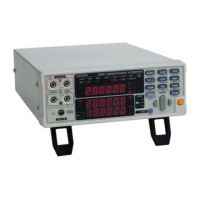43
4.5 Measurement Fault Detection Function
If a measurement does not execute properly, a measurement fault is
indicated on the display.
In addition, a measurement fault signal (ERR) is output at the EXT I/O
connector.
❖ Chapter 6 External Control (Page 77)
A measurement fault is displayed in the following cases.
• When the resistance of the measured object is over-range
Example: Attempting to measure 20 Ω with the 20 mΩ range
selected.
• If any of the following is open, or has a bad connection: SOURCE H,
SOURCE L, SENSE H, SENSE L
• If the circuit protection fuse is blown
❖ 10.1 Inspection, Repair and Cleaning (Page 167)
• If the temperature probe is connected incorrectly
4.5 Measurement Fault Detection Function
Error Display Cause
1 ErrCur
Constant-current fault
2 ErrHi
SENSE-H line is open
3 ErrLo
SENSE-L line is open
4 - - - - -
Any combination of 1 to 3
The following cases are detected as measurement faults. However, if
the capacitance of the test leads is 1 nF or higher, the measurement
fault may not be detected.
• When the resistance between SOURCE-H and SENSE-H is
greater than about 50 Ω
• When the resistance between SOURCE-L and SENSE-L has the
following values:
Low Power function and 20 mΩ to 20 Ω range: about 5 Ω
200 Ω or higher range: about 40 Ω
• After the probes contact the test object, at least about 500 µs is
required for measurement stabilization.
This instrument’s measurement fault detection function begins
detecting measurement faults about 500 µs before INDEX goes
Low (OFF).
Therefore, if the Delay is set to 0.000 s, measurement faults that
may occur before INDEX goes Low cannot be detected. To ensure
reliable measurement, we suggest setting the Delay to at least 1
ms.

